Exploring New York's Saratoga Mineral Springs Waters
by Richard O. Aichele Email Contact richaichele@aol.com Copyright 2015 & 2024 by Richard O. Aichele - InforWorks.com |
Saratoga's Regional Geological Evolutions |
The Saratoga region in New York State had the geological good fortune to have a variety of underground mineral waters within a small geographical area. Most of the mineral waters had an ample combination with carbonic gas that increased the beverages bubbly appeal as a drink and also when used in medicinal waters for bathing. |
|
During the past 245 years, Ballston Spa had a total of 19 named mineral water springs that were active at different times. The Sans Souci Springs group of springs included the Low's Spring, Sulphur Spring, Park Spring and the San Souchi Spring.
|
Saratoga Spa Park Mineral Springs |
In Saratoga Springs, the availability of the mineral waters and growing interest in Balneology, bath houses, spa health treatments and nking fountains attracted attention in the late 1800s. Te geological good fortune also attracted inustrial developers, known as the gas companies, using the mineral water sources to extract the carbonic gas for resale. The process resulted in wasting the mineral waters by dumping them onto the surfaces. By 1907, the gas companies' overexploitation of the underground supply by drilling hundreds of wells was obvious. Local citizens and the State of New York took action. The Wall Street Journal called for state takeover of the gas companies' properties because, "It looks in fact, as if individual selfishness would finally leave the medicinal springs as extinct as the buffalo." By 1915, New York State legally acquired the gas company properties and began preservation of the underground mineral water sources and creation of the state reservation.
|
A centerpiece of the original Spas' goal to develop mineral water therapies and benefits to people of all economic levels was the Simon Baruch Research Institute building. The cornerstone of the Simon Baruch Research Laboratory was laid September 14, 1934. Simon Baruch was an American pioneer in the fields of Balneology, mineral water therapeutic medical treatments and public health issues. He was active in the early days (1910 era) of Saratoga Spa to establish it as "the ideal place to study the nature and course of chronic diseases, a subject which the medical profession had neglected in favor of studying and concentrating on the more demanding acute diseases of the time," according to Grace Maguire Swanner, M.D. With the completion of the laboratory building, the opening ceremony was called "Realization of the Dream of 1910." |
The state rebuilt a former gas company wood construction building into the first Lincoln Bath House. It burned in 1929 and within three years a new modern Lincoln Bath House. was opened. During those years, the state's newest Washington Bath House opened in 1920. They were followed by construction of the Roosevelt One and the Roosevelt Two bath houses built during the Great Depression of the 1930s. Both buildings had almost identical bath and other health services. During and after World War 2, the U.S. Veterans Administration used the facilities for therapeutic mineral water treatments of wounded servicemen. |
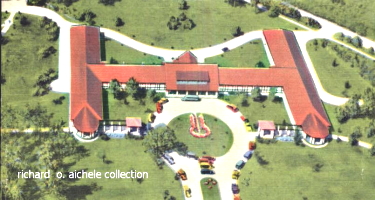 |
 |
Left: The Washington Bath House. Right: The Lincoln Bath House. The cornerstone was laid July 12, 1933 for Hall of Springs. The event marked the beginning of the New Spa's development. Mineral waters from the Geyser, Hathorn, and Coesa springs were piped directly into the Hall of Springs for patrons to drink while they enjoyed live orchestral music. The Hall of Springs included a concert hall, a promenade, writing rooms, lounges, and a restaurant, was the centerpiece of the Spa Park complex. Exterior decorative statues show a female representing Earth and a male statue representing Water. Today the Hall of Springs serves as a banquet hall and no longer serves Spa Park mineral waters. The Spa Park was complete with mineral springs, four bath houses, laboratory, hotel, theatre and other features. The spa facilities were often used by area doctors that sent their patients to the spa for specific medical treatments and Balneology therapies. During and after World War 2 the spa served wounded servicemen recovering from war wounds. As a state reservation, operations had always been the responsibility of the state. The Saratoga Spa operations were first threatened in the 1950s when a New York State commission known as the Little Hoover Commission recommended that the Spa be abolished. Swanner's book Saratoga Queen of Spas also notes, "Legislature cut a large slice of the budget appropriations for the Spa. It was the first of a long series of reductions in operating funds that contributed to reduced services to Spa clients and the resulting steady decline of Spa clients." |
Drinking Saratoga Springs Mineral Waters |
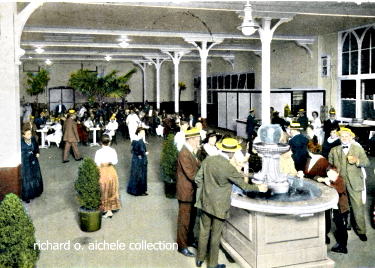 |
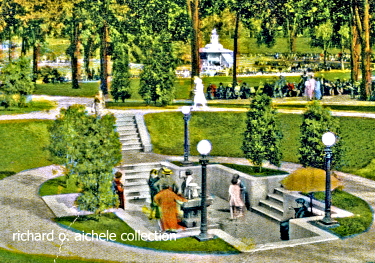 |
Top: - 1920s Era Drink Hall and Congress Park Fountain |
Below: - 1950s Era - Hall of Springs Fountain Counters in Saratoga Springs Spa State Park. |
 |
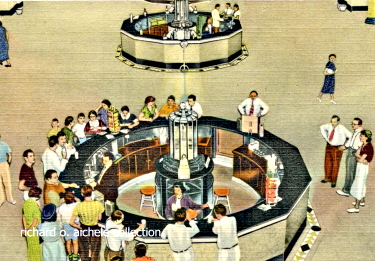 |
Saratoga Mineral Water's Geological Evolutions | 11,000 Years Ago and Deep Down | by Richard O. Aichele The geological process began about 11,000 years ago deep below the earth's surface eventually producing sources of water enriched by minerals extracted from different layers of stone and from organic substances. In the 17th Century, Native American Indians found that the water seeping under pressure from the ground had a good taste and was also a healing agent for wounds. They introduced the waters to early colonists and the work to understand the mineral water sources began. As glaciers moved southward about 18,000 years ago, they altered the subsurface composed of sandstone or dolomite layers called Amsterdam limestone. Four thousand years later, the glaciers retreated northward again altering the surface structures. In addition, "the weight of the ice sheets caused the landscape to be depressed known as Isostatic depression. Once the glaciers left over the course of many thousands of years the land surface had risen known as Isostatic rebound when the crushing weight of mile thick ice was removed," explained Andrew Kozlowski, Quaternary Geologist at the New York State Museum in Albany, NY. The glaciers northward retreating movements left behind considerable melt water that created very large lakes. On the eastern side of New York State, the glacial Lake Albany extended from Poughkeepsie northward to Glens Falls. It was bordered on the east side by Taconic highlands and westward limited by surface elevations such as the Heldererberg Escarpment. Kozlowski explained, "Lake Albany's maximum Lake surface height was about 360 feet above mean sea level." At that water height, the Saratoga region was underwater. For reference, the current Spa Park wells are at elevations between 200 and 300 feet above mean sea level. Ultimately, Lake Albany drained and its water flow southward deepened and widened the Hudson valley. In the Saratoga region, glacial movements helped create the subsurface structure composed of sandstone or dolomite layers called Amsterdam limestone. Some parts of this New York State region have a layer of Canajoharie shale above the dolomite layers. Over time, the limestone layer was continually partially decomposing creating underground cavities were. Over time they were connected by channels that allowed the waters to circulate throughout the area. Simultaneously the water absorbed minerals from the underground rocks while also combining with the carbon dioxide natural gas. Natural faults in the earth's structure allowed the mineral waters chared by carbonic gas to escape upward. Two natural underground barriers have protected the purity of the mineral waters. They prevent the mineral waters from escaping upward while also preventing ground water from reaching the deep underground mineral water cavities. Since the late 1800s, extensive drilling of wells in Saratoga Spa Park have compromised the purity of the mineral waters to some degree. One barrier is the Canajoharie shale above the dolomite layers which formed a waterproof shield locking in the different underground carbonated mineral waters. The other barrier was believed created by the lake bed of Lake Albany. The settlement to the lake bottom of various substances including earth carried by glacial waters created a thick dense clay layer often approximately 50 feet thick preventing contamination of the mineral water sources. After the lake drained other ground covers collected over the hard clay. These geological features centuries later in Saratoga Spa Park allowed drilled wells with mineral water flows having significant differences of mineral content and varying tastes. The depths of the underground mineral water pools also resulted in varying mineral content and taste in wells only hundreds of feet apart. One example of the natural barrier layers of various stones and types of soils was evident at Geyser Spring. The core samples examined while redrilling the spring revealed the geological subsurface composition that was created thousands of years ago. From the surface, the well drilling equipment first passed through 85 feet of Yellow Sand then 70 feet of Clay then 95 feet of Shale then 15 feet of Shale and Limestone the drill then reached thetop of Dolomite layers. The drilled hole reached a depth of 330 feet and underground water flowed upward. Grace Maquire Swanner, M.D., a former medical Balneology consultant in Saratoga Springs, New York, provided this geological overview: "According to geologists, waters coming from beneath the surface of the earth are classified in three groups: meteoric - waters which are derived from rainfall, magmatic- waters contained in igneous rocks which were formed by crystallization of the molten mass evicted from deep within the earth, and connate - waters derived from sedimentary rocks formed by the laying down of sediments in ancient seas." Active mineral water springs are either natural with the underground water reaching the surface through faults in the surface or man-made by drilling down to reach the underground water cavities. Saratoga's drilled springs produce mineral water each with distinctive mineral compositions. |
Spa Park Springs |
After the gas companies properties were acquired by the state in 1917, detailed studies were made to determine the extent of damage to the underground mineral water geology. The gas companies had 163 drilled wills to capture the gas and the water was wasted. New York State capped all drilled wells except eighteen. The effects were immediate and continued to improve over time. Swanner reported: "There was a marked increase in the water levels of all the springs and some springs which had ceased to flow were running again under their own natural gas pressures. Pumped wells which had never flowed freely before now burst forth as all natural springs. The Island Spouter in Geyser Park began to overflow with natural mineral water for the first time in its history. During the era of pumping, this well had been a large producer of so-called dry gas. The large production of gas was made possible by keeping the water level low by heavy pumping of adjacent wells. Two days after those pumps were stopped the level of the water in the Island Spouter well had risen to a point where it sealed off the underground gas vein and the well ceased to yield gas and overflowed with mineral water."
Careful management by the park staff of the remaing wells has resulted in significant restoration of the underground geology.
Most of the springs in Spa Park are classified as carbonated mineral water springs as a result of their naturally occurring minerals and carbonic gas content. According to Swanner's book, while in the 1930's era there were still fifteen springs that were being "principally marketed pure still waters." Research at the Saratoga Reservation's laboratory identified two of the sources among the fifteen that were superior in quality. "The spring showing the smallest total was found in the ravine near the Willow Gate of Geyser Park and was chosen for development." Geologically, that source's "upper stratum of sand is entirely sealed off from the more soluble rock by an impervious table of clay; the water bubbles forth from the sands which are silaceous and insoluble in water." Today, these "non-carbonated, non-mineral spring water" sources
are known as State Seal Water and Ferndell Spring water located at the Geyser picnic area, the Bruno Pavilion and along the Ferndell Trail. |
Rediscovering the Champion Number 2 Spring |
Once A Famous Spa Park Spouter |
|
The Champion Number 2 spring underwent many artistic changes from a vesical water spray to less water directed into a decorative glass ball then back to the vertical upward water spray in the lower 1937 image and finally aiming the water spray into the pond as shown in the upper image. The Champion 2 well head is at an altitude of 300 feet above sea level, the 8 inch diameter well casing extended down 300 feet and the well flowed at an impressive rate of 150 gallons per minute. |
The broken concrete structures shown near the wellhead were the remains of the original platform. The platform's six foot long end wall with a base 30 inches in thickness and faced with decorative stone and rested on a poured concrete foundation approximately 36 inches wide and more than 18 inches high. The remaining side wall structures were similarly substantial. A concrete frame broken in several places was likely the wellhead access opening in the concrete platform's top surface. The overall original design of the platform originally provided a large barrier that protected the adjacent dirt embankment from erosion by the Geyser Creek's water as Geyser Creek water emerged from the tunnel. Aichele's research indicated a blockage of the tunnel inlet by debris during a severe storm suddendly broke sending flash flood waters through the tunnel and out the platform end with a force that destroyed the platform and the Champion Number 2's fountain. It was never rebuilt. |
|
Mineral Water Health Hydro - Theraphy Concepts |
Drink halls built in the park and in Saratoga Springs NY gave visitors easy access to enjoy drinking the healthful mineral spring waters in pleasant environments. At any of the mineral springs, the initial major attraction was the opportunity to drink the waters. The medical benefits of the different waters was promoted by the spring operators and sought after by the public. Dispensing the waters was initially done by the small glasses at the springs. In more popular areas, the springs' owners built permanent structures called Drink Halls that were often ornate inside to improve the public's perception of the spring. |
Healthier Living With Mineral Waters |
In the early 1900s, the quality of the mineral waters available at Saratoga Springs, New Yorkwas considered equal to those of the European spas but the variety of mineral contents from different wells exceeded those of some European spas. Most of the many drilled mineral springs in what is now Saratoga Springs State Park were shut down and sealed in the 1920s. Nine of the best were made available for drinking purposes at fountains throughout the park, formerly used at the Hall of Springs or also used as bottled waters. |
The fifteen chemical compositions of those Saratoga Springs' mineral well waters in a small geographical area have an interesting variety. Calcium content varies from 465 ppm (parts per million) at Polaris Spring to 1.160 ppm at Hawthorn #3 Spring. Sodium levels at Hayes Spring is 2,610 ppm and 920 ppm at the Lincoln Spring. Stromtium ranges between 4.24 ppm at Polaris Spring and 23.8 ppm at Hawthorn #3 Spring. Lithium is less than 0.05 ppm at the Orenda Spring and 12 ppm at Hayes Spring. Potassium levels among six popular drinking mineral springs varies from 106 ppm to 429 ppm. Those wells are among those with significant Carbon Dioxide content. Two wells known as the State Seal Water and the Ferndell Spring Water do not have noticeable Carbon Dioxide gas and very low mineral levels making them very popular Still Waters for drinking. |
The mid-19th Century witnessed a growth of many European and American health spas built around underground sources of mineral spring waters. Guests enjoyed the mineral waters either by drinking it or bathing in the mineral waters heated to a comfortable temperature. Depending on a water's mineral content, physicians prescribed appropriate medical treatments using the mineral waters for a variety of ailments including arthritis, fibromyalgia, rheumatism, gout, paralysis, neuralgia, and skin diseases. As the mineral springs were discovered, baths were built some of which became architectural landmarks with elegant interior designs to encourage healthful relaxation. |
By early 1950s public interest and use of the mineral springs and hydro spa therapeutic bath facilities in the U.S. gradually decreased. Among the reasons cited in the U.S. for the declining interest in mineral waters therapies was the influence of the growing pharmaceutical industry, promotion of the concept to "just take a pill for whatever hurts," reduced education of Balneology in the healthcare field, elimination of public funding for mineral water health facilities and reduced knowledge of holistic health approaches. |
However, in Europe, the practice of mineral water hydrotherapy treatments has remained strong benefiting both the health of spa users some are under the direction of spa doctors and the healthcare systems. The financial benefits to the economies of the towns and cities near the springs are significant. As a result, many spas are vibrant world class destinations such as Baden-Baden in Germany, Lourdes in France or the Thermal Springs of Saturnia in Italy. Other spas are in towns and smaller cities throughout Europe. |
As with the growing positive trends in holistic health practices, there is also a growing awareness positive trend in the benefits of natural mineral waters. The Balneology Association of North America [BANA] actively promotes greater awareness of the benefits of therapeutic baths and bathing in natural mineral waters through research and education. One element is to increase public knowledge of the importance of various minerals to the human body and how bathing in mineral waters can help met those needs. Every source of natural mineral waters will have different compositions of various minerals. For example, the Baneologo Association of North America identifies the health benefits in five of the minerals commonly found in varying degrees in natural mineral waters. |
Calcium Hydrating with Calcium rich mineral waters allows for a consistent level of calcium in the body's fluids and tissues, which is needed for muscle contraction, blood vessel contraction and expansion, the secretion of hormones and enzymes, and communication through the nervous system. An adequate intake of calcium builds and maintains proper bone mass and helps prevent osteoporosis. . |
Lithium Hydrating with Lithium rich mineral waters can help protect your brain from exposure to the toxins produced by your own body. Toxic molecules are formed naturally during the course of normal brain metabolism. Lithium supports nervous system, mood and sleep. . |
Magnesium Hydrating with Magnesium rich mineral waters su pports energy production, oxidative phosphorylation, and glycolysis. Magnesium is a cofactor in more than 300 enzyme systems that regulate diverse biochemical reactions in the body, including protein synthesis, muscle and nerve function, blood glucose control, and blood pressure regulation. Magnesium also plays a role in the active transport of calcium and potassium ions across cell membranes, a process that is important to nerve impulse conduction, muscle contraction and normal heart rhythm. . |
Potassium Hydrating with Potassium rich mineral waters alkalizes the system by working with sodium to balance body fluids. Potassium helps regulate the heartbeat and is necessary to move nutrients and wastes through the cell walls. More of this mineral is needed when the body is under physical or mental stress. It is a natural pain reducer. |
Sulfur Hydrating with Sulfur rich mineral waters has been used medicinally since ancient times. Also known as "nature's beauty mineral", because your body needs it to manufacture collagen, which helps with skin elasticity and keeps us young looking. Sulfur is contained in every cell in the body. Approximately 0.25 percent of your total body weight is sulfur. It is most concentrated in keratin which gives you strong hair, nails and skin. Sulfur eases irritated skin conditions and helps protect the body against toxins in the environment. Inflammation can be relieved by taking a soothing bath in hot sulfur springs.
| Looking Forward The Saratoga Spa Park is increasingly active and popular. Due to the high quality of the original architects and builders work and the continual efforts of park managers and staffs, the approximately 90 year old buildings have survived surprisingly well. With exception of one bath house and the drinking springs, Balneology uses have been eliminated. It is still the hope of many that the holistic mineral waters medicinal treatments and Dream of 1910 may again be revitalized at the Saratoga Spa.
|
___________________________________________


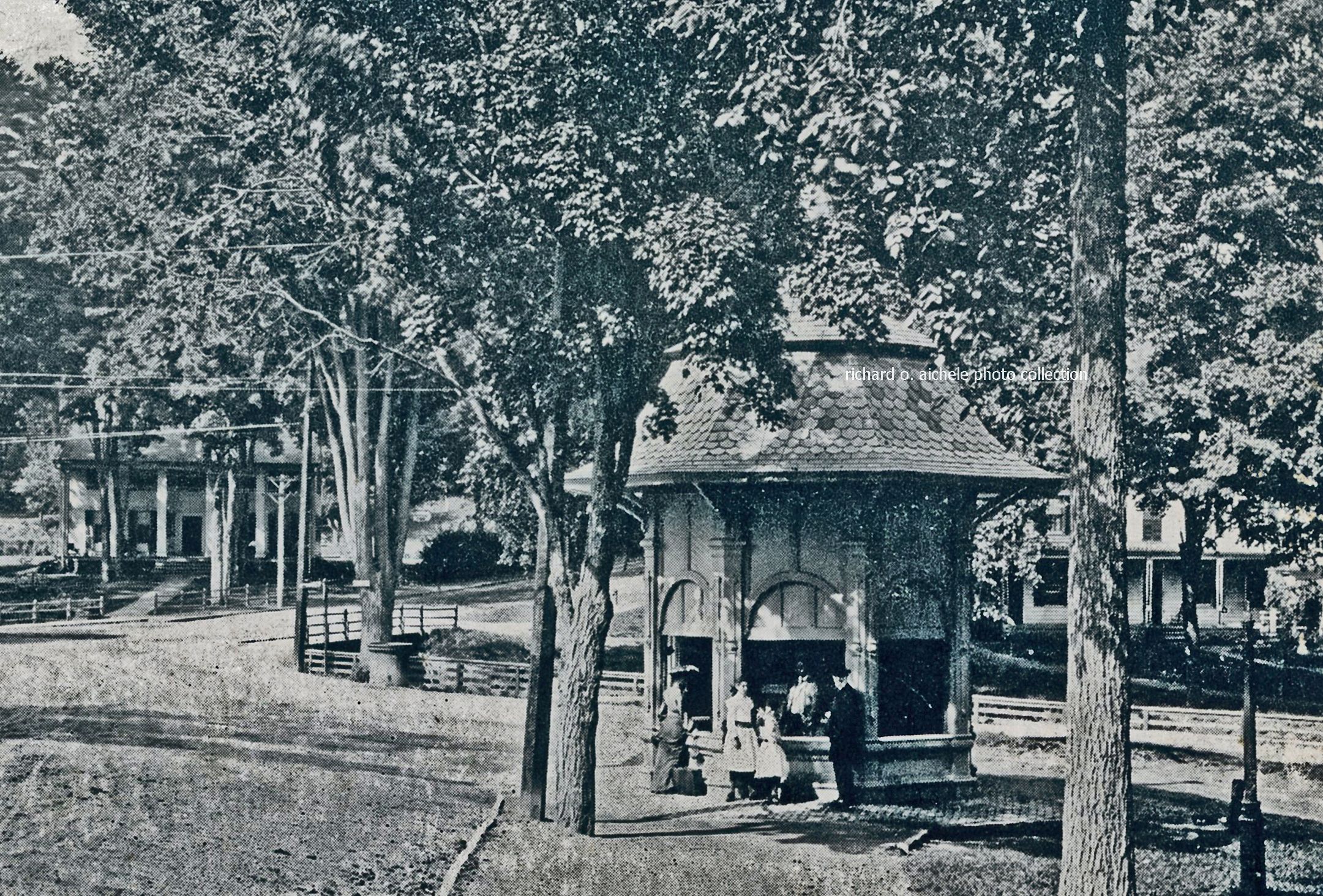 The Old Iron Spring in Ballston Spa was discovered in 1769 by Colonists during surveys of the Kayaderosseras Patent and the spring waters still flow today. This spring and others in the area had been used by Native American Indians for the heathful characteristics of the waters many years earlier. In the late 1800s, (see photo) the area around the Old Iron Spring was continually improved including construction of the Spring House. The Spring House was restored during the 1990s and serves refreshing mineral water during special events.
The Old Iron Spring in Ballston Spa was discovered in 1769 by Colonists during surveys of the Kayaderosseras Patent and the spring waters still flow today. This spring and others in the area had been used by Native American Indians for the heathful characteristics of the waters many years earlier. In the late 1800s, (see photo) the area around the Old Iron Spring was continually improved including construction of the Spring House. The Spring House was restored during the 1990s and serves refreshing mineral water during special events. 
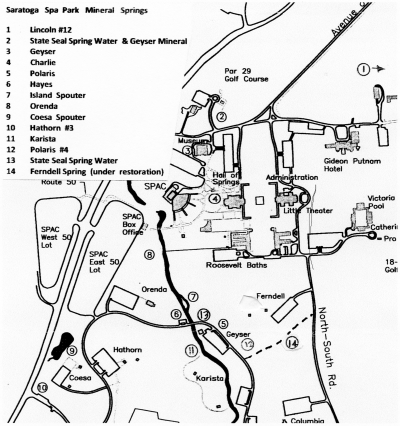 Capturing the carbonic gas from undergound sources was profitable for private companies but a disaster for the underground water sources.
Capturing the carbonic gas from undergound sources was profitable for private companies but a disaster for the underground water sources.
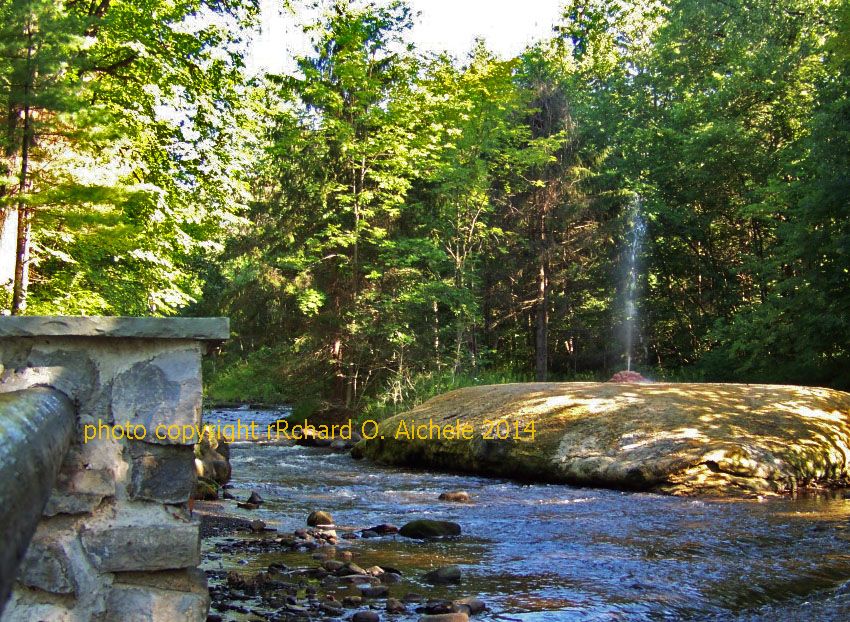 Today the Spa Park's active mineral springs such as the Island Spouter shown here can be reached by using the park's excellent trail system or with easy access from the park roads.
Today the Spa Park's active mineral springs such as the Island Spouter shown here can be reached by using the park's excellent trail system or with easy access from the park roads. 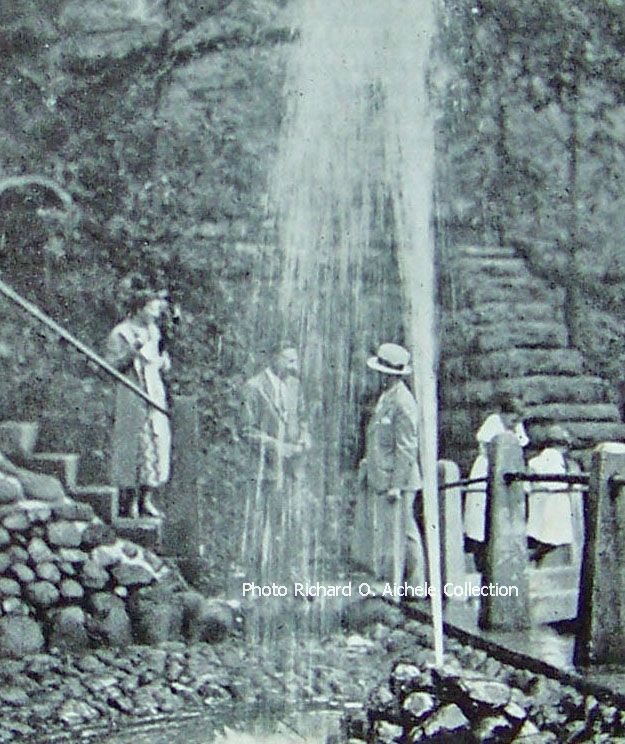 In the late 1800's, the Saratoga underground waters gas content became commercially valuable. Three of the most powerful springs were drilled on the private Champion Natural Gas Company property and they became famous in the Saratoga Region. Champion spring well Number 1 spouted water over 100 feet into the air. It became famous enough that the passenger trains between New York City and Montreal, Canada often slowed to give passengers a view of the spouting spring waters. Champion Natural Gas drilled two other wells,
In the late 1800's, the Saratoga underground waters gas content became commercially valuable. Three of the most powerful springs were drilled on the private Champion Natural Gas Company property and they became famous in the Saratoga Region. Champion spring well Number 1 spouted water over 100 feet into the air. It became famous enough that the passenger trains between New York City and Montreal, Canada often slowed to give passengers a view of the spouting spring waters. Champion Natural Gas drilled two other wells, 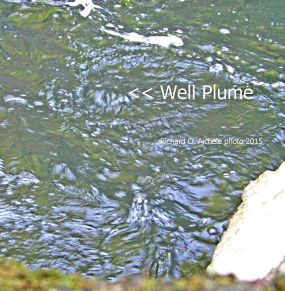 After the destruction of the observation platform, general interest in the Champion Number 2 spring ended and memories of spouter spring generally were lost. A lengthy search for the long-lost Champion Number 2 spouter spring was made by Richard O. Aichele and on August 25, 2015 it was unexpectedly successful. He had often surveyed the collapsed concrete platform area, studied historic geological records and maps. With newly acquired old photographs, he determined the probable location of the drilled Champion 2's wellhead. On that day, due to low water level of Geyser Creek, he observed unusual upward turbulence in the Geyser Creek which he believed was near the possible location of Champion Number 2 spring. A follow-up underwater investigation confirmed the upward turbulence was in fact the long-lost Champion Number 2 spouter's wellhead that was still flowing freely.
After the destruction of the observation platform, general interest in the Champion Number 2 spring ended and memories of spouter spring generally were lost. A lengthy search for the long-lost Champion Number 2 spouter spring was made by Richard O. Aichele and on August 25, 2015 it was unexpectedly successful. He had often surveyed the collapsed concrete platform area, studied historic geological records and maps. With newly acquired old photographs, he determined the probable location of the drilled Champion 2's wellhead. On that day, due to low water level of Geyser Creek, he observed unusual upward turbulence in the Geyser Creek which he believed was near the possible location of Champion Number 2 spring. A follow-up underwater investigation confirmed the upward turbulence was in fact the long-lost Champion Number 2 spouter's wellhead that was still flowing freely. 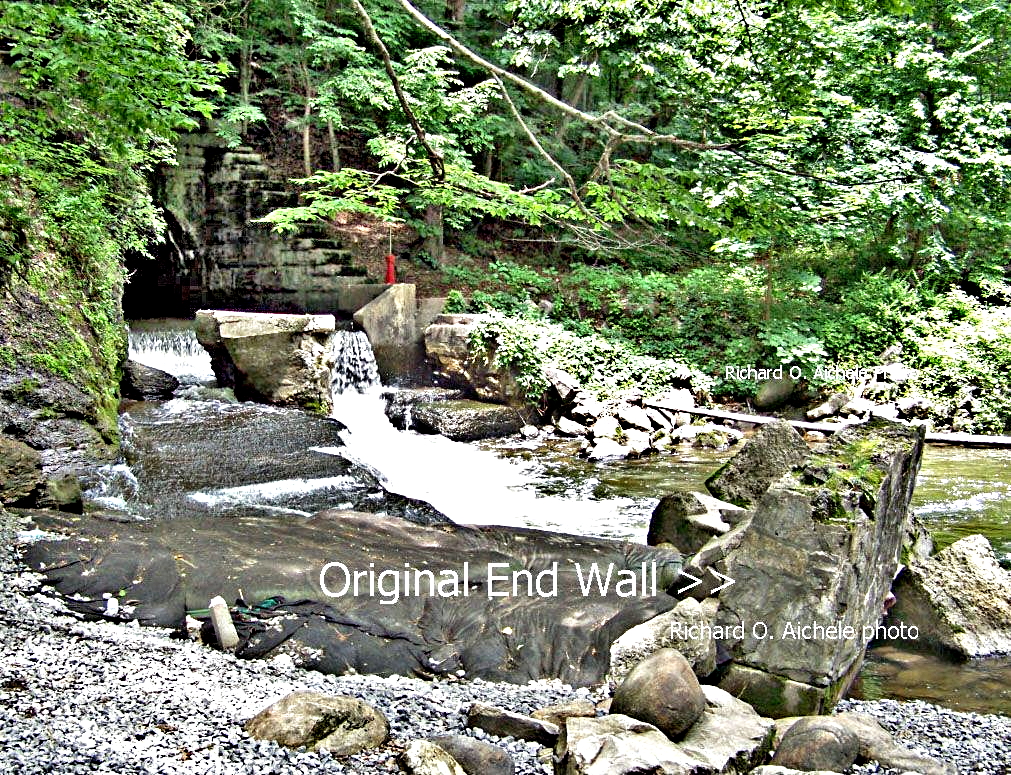
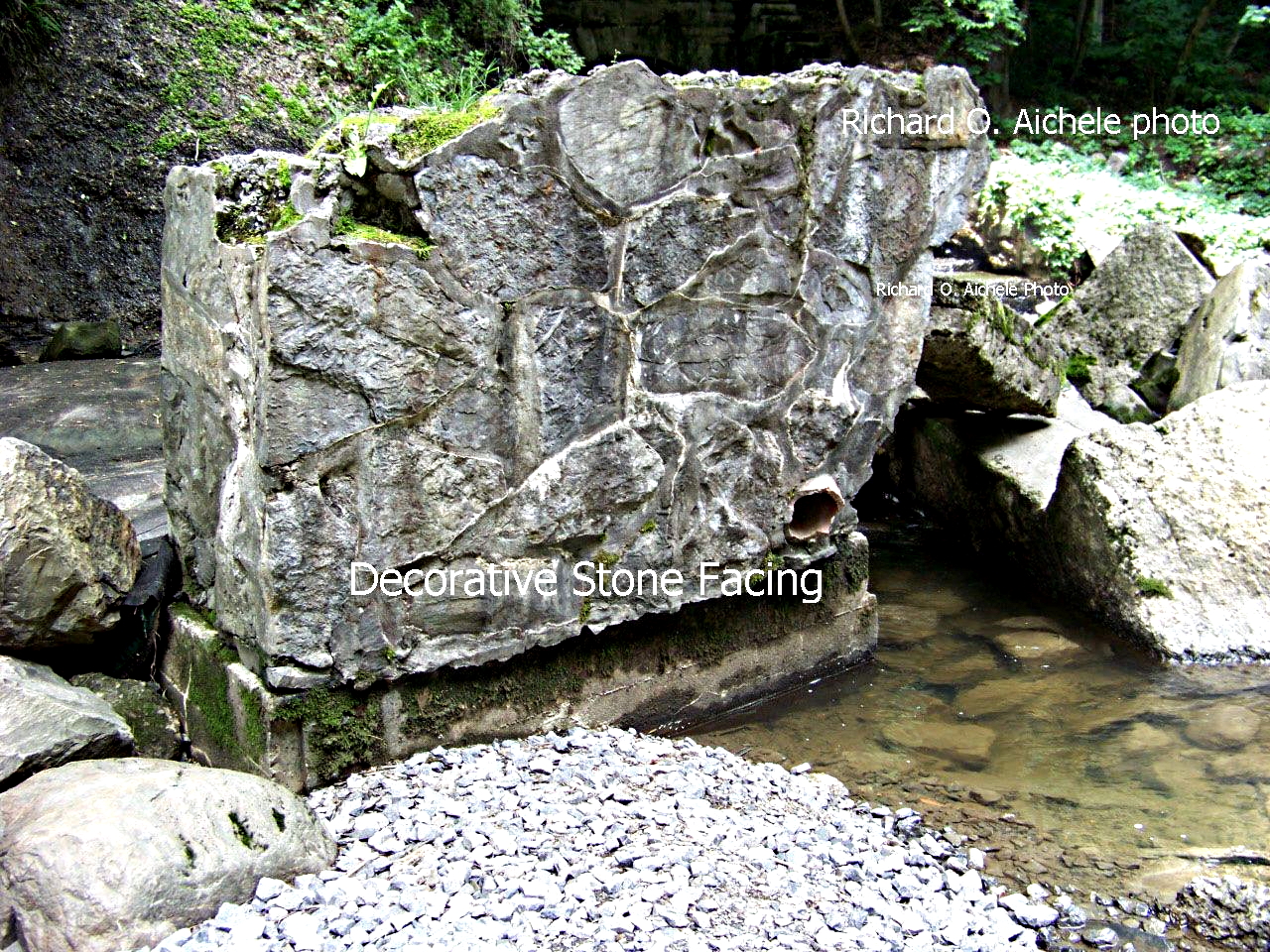
 Just regularly drinking some of the mineral waters for health reasons was very popular for many years. Commonly, the beneficial waters were available for drinking at mineral water fountains near the springs or less often as bottled mineral water. One example, the spa at Saratoga Springs State Park in New York once offered three distinct types of bottled mineral waters and one still water from the park's wells. The park had two bottling plants to ensure mineral water purity from the wellhead to the bottle. The famous Hall of the Springs in the park dispensed mineral water piped directly from the Geyser Spring, the Coesa Spring and the Hathorn Spring located some distance from the building.
Just regularly drinking some of the mineral waters for health reasons was very popular for many years. Commonly, the beneficial waters were available for drinking at mineral water fountains near the springs or less often as bottled mineral water. One example, the spa at Saratoga Springs State Park in New York once offered three distinct types of bottled mineral waters and one still water from the park's wells. The park had two bottling plants to ensure mineral water purity from the wellhead to the bottle. The famous Hall of the Springs in the park dispensed mineral water piped directly from the Geyser Spring, the Coesa Spring and the Hathorn Spring located some distance from the building.